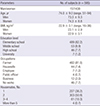1. Choi HJ, Shin CS, Ha YC, Jang S, Jang S, Park C, Yoon HK, Lee SS. Burden of osteoporosis in adults in Korea: a national health insurance database study. J Bone Miner Metab. 2012; 30:54–58.
2. Lee SR, Ha YC, Kang H, Park YG, Nam KW, Kim SR. Morbidity and mortality in Jeju residents over 50-years of age with hip fracture with mean 6-year follow-up: a prospective cohort study. J Korean Med Sci. 2013; 28:1089–1094.
3. Yoon HK, Park C, Jang S, Jang S, Lee YK, Ha YC. Incidence and mortality following hip fracture in Korea. J Korean Med Sci. 2011; 26:1087–1092.
4. Choi YJ, Oh HJ, Kim DJ, Lee Y, Chung YS. The prevalence of osteoporosis in Korean adults aged 50 years or older and the higher diagnosis rates in women who were beneficiaries of a national screening program: the Korea National Health and Nutrition Examination Survey 2008-2009. J Bone Miner Res. 2012; 27:1879–1886.
5. Kanis JA, McCloskey EV, Johansson H, Cooper C, Rizzoli R, Reginster JY; Scientific Advisory Board of the European Society for Clinical and Economic Aspects of Osteoporosis and Osteoarthritis (ESCEO) and the Committee of Scientific Advisors of the International Osteoporosis Foundation (IOF). European guidance for the diagnosis and management of osteoporosis in postmenopausal women. Osteoporos Int. 2013; 24:23–57.
6. Bessette L, Ste-Marie LG, Jean S, Davison KS, Beaulieu M, Baranci M, Bessant J, Brown JP. The care gap in diagnosis and treatment of women with a fragility fracture. Osteoporos Int. 2008; 19:79–86.
7. Giangregorio L, Papaioannou A, Cranney A, Zytaruk N, Adachi JD. Fragility fractures and the osteoporosis care gap: an international phenomenon. Semin Arthritis Rheum. 2006; 35:293–305.
8. Hiligsmann M, Salas M, Hughes DA, Manias E, Gwadry-Sridhar FH, Linck P, Cowell W. Interventions to improve osteoporosis medication adherence and persistence: a systematic review and literature appraisal by the ISPOR Medication Adherence & Persistence Special Interest Group. Osteoporos Int. 2013; 24:2907–2918.
9. Sale JE, Beaton D, Posen J, Elliot-Gibson V, Bogoch E. Systematic review on interventions to improve osteoporosis investigation and treatment in fragility fracture patients. Osteoporos Int. 2011; 22:2067–2082.
10. Laliberté MC, Perreault S, Jouini G, Shea BJ, Lalonde L. Effectiveness of interventions to improve the detection and treatment of osteoporosis in primary care settings: a systematic review and meta-analysis. Osteoporos Int. 2011; 22:2743–2768.
11. Little EA, Eccles MP. A systematic review of the effectiveness of interventions to improve post-fracture investigation and management of patients at risk of osteoporosis. Implement Sci. 2010; 5:80.
12. Gleeson T, Iversen MD, Avorn J, Brookhart AM, Katz JN, Losina E, May F, Patrick AR, Shrank WH, Solomon DH. Interventions to improve adherence and persistence with osteoporosis medications: a systematic literature review. Osteoporos Int. 2009; 20:2127–2134.
13. Kendrick D, Kumar A, Carpenter H, Zijlstra GA, Skelton DA, Cook JR, Stevens Z, Belcher CM, Haworth D, Gawler SJ, et al. Exercise for reducing fear of falling in older people living in the community. Cochrane Database Syst Rev. 2014; CD009848.
14. Black DM, Reid IR, Boonen S, Bucci-Rechtweg C, Cauley JA, Cosman F, Cummings SR, Hue TF, Lippuner K, Lakatos P, et al. The effect of 3 versus 6 years of zoledronic acid treatment of osteoporosis: a randomized extension to the HORIZON-Pivotal Fracture Trial (PFT). J Bone Miner Res. 2012; 27:243–254.
15. Delmas PD. Treatment of postmenopausal osteoporosis. Lancet. 2002; 359:2018–2026.
16. Hochberg MC, Thompson DE, Black DM, Quandt SA, Cauley J, Geusens P, Ross PD, Baran D; FIT Research Group. Effect of alendronate on the age-specific incidence of symptomatic osteoporotic fractures. J Bone Miner Res. 2005; 20:971–976.
17. Ha YC, Chun HJ, Hwang HK, Kim BS, Kim JR. The prevalence, awareness, treatment, and control of hypertension, and related factors in rural Korea. Korean J Prev Med. 2000; 33:513–520.
18. Ha YC, Lee JS, An SH, Ham JR, Na JB, Kim JR, Kim BS, Kim SY. An epidemiological study of osteoporosis in Ibansung-meon, Jinju, by using quantitative ultrasound. Korean J Bone Metab. 2005; 12:217–223.
19. Heyworth L, Kleinman K, Oddleifson S, Bernstein L, Frampton J, Lehrer M, Salvato K, Weiss TW, Simon SR, Connelly M. Comparison of interactive voice response, patient mailing, and mailed registry to encourage screening for osteoporosis: a randomized controlled trial. Osteoporos Int. 2014; 25:1519–1526.
20. Yuksel N, Majumdar SR, Biggs C, Tsuyuki RT. Community pharmacist-initiated screening program for osteoporosis: randomized controlled trial. Osteoporos Int. 2010; 21:391–398.
21. Cook PF, Emiliozzi S, McCabe MM. Telephone counseling to improve osteoporosis treatment adherence: an effectiveness study in community practice settings. Am J Med Qual. 2007; 22:445–456.
22. Lafata JE, Kolk D, Peterson EL, McCarthy BD, Weiss TW, Chen YT, Muma BK. Improving osteoporosis screening: results from a randomized cluster trial. J Gen Intern Med. 2007; 22:346–351.
23. Elliott ME, Meek PD, Kanous NL, Schill GR, Weinswig PA, Bohlman JP, Zimpel CL, Jensen BC, Walters DR, Sutter SL, et al. Pharmacy-based bone mass measurement to assess osteoporosis risk. Ann Pharmacother. 2002; 36:571–577.
24. Goode JV, Swiger K, Bluml BM. Regional osteoporosis screening, referral, and monitoring program in community pharmacies: findings from project ImPACT: osteoporosis. J Am Pharm Assoc. 2003; 2004:152–160.
25. Naunton M, Peterson GM, Jones G. Pharmacist-provided quantitative heel ultrasound screening for rural women at risk of osteoporosis. Ann Pharmacother. 2006; 40:38–44.
26. Ahlborg HG, Rosengren BE, Järvinen TL, Rogmark C, Nilsson JA, Sernbo I, Karlsson MK. Prevalence of osteoporosis and incidence of hip fracture in women--secular trends over 30 years. BMC Musculoskelet Disord. 2010; 11:48.
27. Glüer CC; The International Quantitative Ultrasound Consensus Group. Quantitative ultrasound techniques for the assessment of osteoporosis: expert agreement on current status. J Bone Miner Res. 1997; 12:1280–1288.







 PDF
PDF ePub
ePub Citation
Citation Print
Print





 XML Download
XML Download